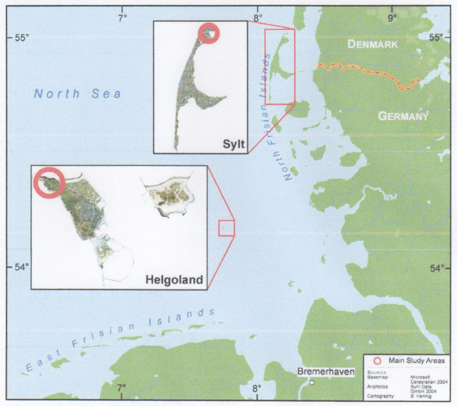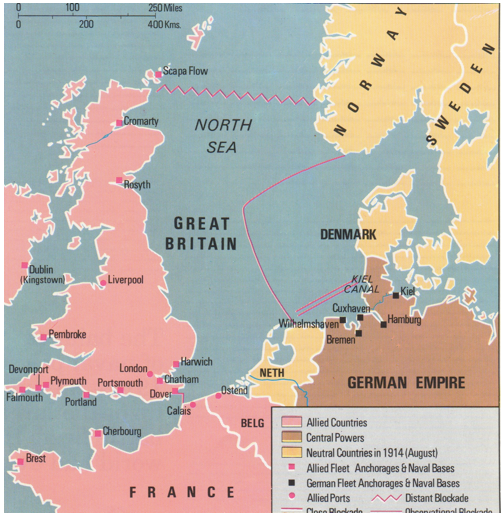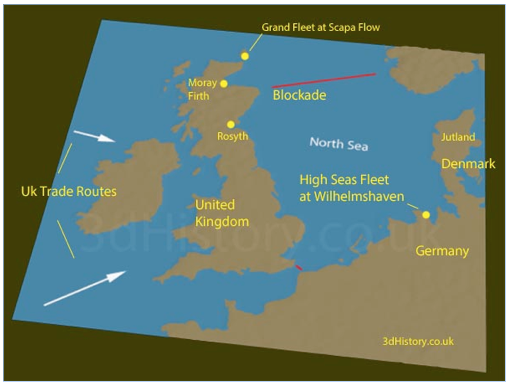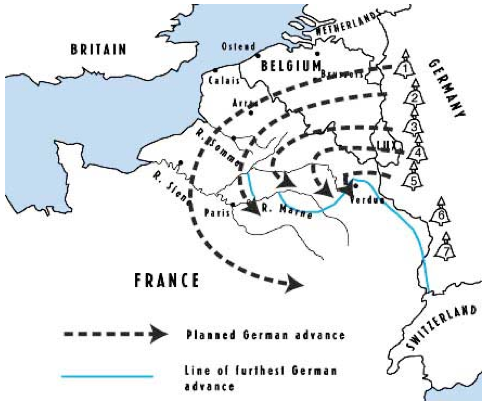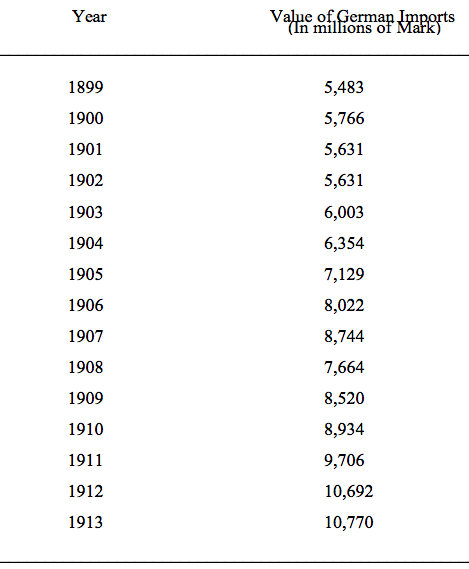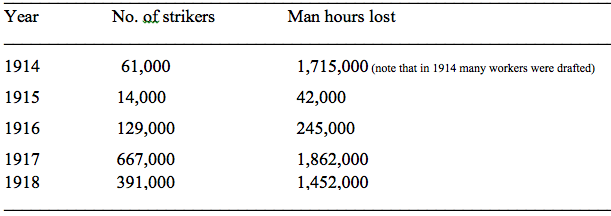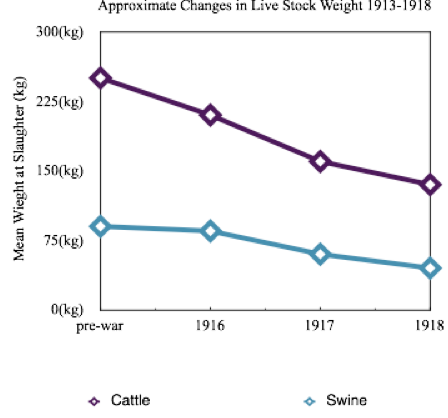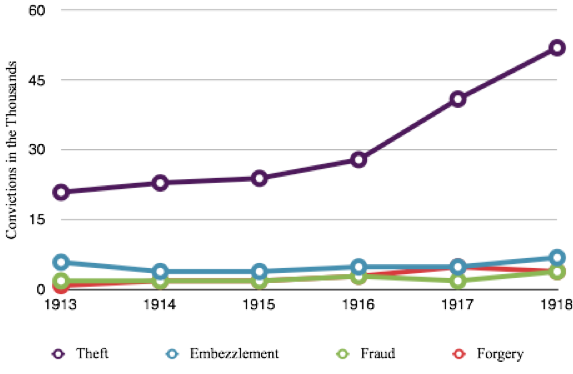Featured Article:The British Blockade During World War I: The Weapon of Deprivation
By
2014, Vol. 6 No. 06 | pg. 5/5 | « Revolutionary Specter & PeaceThe year 1917 proved to be the pivotal point for the German war effort, even if both the Entente and the Central powers did not realize it at the time. If we recall, 1916 was the first year that widespread increases in civil disobedience occurred throughout Germany. This trend continued to grow moving into 1917-1918, and showed little sign of slowing down (see Table 2.2 in Appendix). As millions waited in never ending ration lines for meager allowances, or went cold during the long winter months because of the scarce availability of coal or new clothing, the morale of the German people began to plummet rapidly. The first signs of serious unrest began in April 1917 with the Berlin metal strikes. On the morning of the sixteenth, nearly 200,000 metal and munitions workers refused to report to their jobs, and rather assembled in large groups to begin active demonstrations. According to reports from that day, most of the protesters struck over the 'food question.'60 By nightfall, Berlin fell quiet once more as had been previously planned by union leadership, leaving government officials to ponder if protests like this would rapidly become the norm rather than the exception. While this stoppage did not effect the soldiers at the front, should the conditions continue to deteriorate in Germany, the war effort could ground to a halt quickly. Without munitions, equipment, or weapons pouring out of German factories, the army would stand little chance of defending its positions in the trenches, let alone launch any kind of major offense to break the deadlock. U.S. President Herbert Hoover once noted that, "Famine is the mother of anarchy. From the inability of governments to secure food for their people, grows revolution and chaos."61 Events in Germany throughout the rest of 1917-1918 proved him right. Following the Berlin metal strikes, protests continued to increase with more frequency and intensity as the German civilian population continued to starve, and the prospect of another long cold winter loomed on the horizon. Again throughout August, 1917, renewed riots and demonstrations took place, only this time they encompassed more than just munitions and metal workers in the German capital. Widespread protest grew throughout the country seemingly overnight, and saw men, women, and children from every strata of the population take part in the chaos. In Berlin alone, violent daily battles over food took place on the Alexanderplatz grounds, Berlin's largest market place.62 According to one report compiled by Officer Schrott, "The market halls are daily stormed by hundreds of women ... it often comes to wild [wüste] rows, looting, and even to blows ... There is great tension and hatefulness among the people."63 Other citizens threw decency to the wind, and simply slaughtered horses in the middle of the streets, or rummaged through piles of garbage for traces of food or fuel (see Image 1.1 & 1.2 in Appendix).These scenes of violence and disruptions continued in Germany throughout the rest of the war, and showed little sign of peacefully dying down like they had in 1916. In late 1917, and early 1918, it must have seemed to German leaders as if the country was on the brink of revolution, or that the red tide of Bolshevism would sweep westward and engulf the nation by storm just as it had in Russia the previous year. As reports of another poor harvest spread in late 1917, the morale throughout Germany began to plummet even further. According to one account, during 1917-1918, Germans stopped worrying about the war, and only the lack of food filled their hearts and minds.64 Repeated reports from police agents warned that broad ranges of the population intended to follow the Spartacist calls to bring down the government, and enact a general peace that would relieve their suffering once and for all.65 Other reports feared that it was not just adults that might fall prey to revolutionary manipulation, but that the easily moldable German adolescents might also fall prey to leftist agitation as well. According to a summary compiled by the Centre for the Care of the Young, many juvenile prisoners felt as if they were 'absolutely innocent,' and this bitterness coupled with the lack of food due to the blockade would allow many to fall easy prey to the 'Bolshevist agitator.'66 According to Belinda Davis, only the renewal of unrestricted U-boat operations against British and French shipping on January 31, 1917, and peace negotiations in the east later in December, 1917, stopped the country from following the revolutionary path that brought Russia out of the war by the end of that year.67 Even still, the supposed Burgfrieden - 'fortress of peace' a term used by the Wilhelmian government to described the German political and social unity, and lack of opposition for the war -68 began to crack at its foundations in early 1917. As the food and material shortages in Germany worsened during the last two years of the war, popular unrest grew along with it. Andreas Hillgruber explained that by the summer of 1917, the Social Democrats, Progressive People's Party, and National Liberals - the three leading socialist parties in Germany - all used the deteriorating situation at home to justify calls for immediate reform of the government, something that had been promised to them by the Kaiser if they supported the war until its end. They threatened that the current government could not count on the continued support of party leadership, nor the already upset and war-weary workers should their demands be ignored.69 Therefore the blockade was the catalyst to further unrest, which combined with the fact that the war seemed to have no end in sight, caused the fragile situation throughout Germany to turn quickly. Growing revolutionary fervor throughout the home front was the not the only source of concern for Germany's leaders. What started out as social unrest within Germany itself, quickly spread to the various branches of the military as well. Beginning in June, 1917, and continuing through early August, hunger and furlough strikes quickly morphed into anti-war mutinies on board the German battleship Prinzregent Luitpold, anchored at the northern German port of Wilhelmshaven.70 While unrest was quickly subdued due to prompt action by the fleet commanders, it was here again in Germany's northern ports that the seeds of revolt would spring up in the last days of the war, and become the spark that turned into the German Revolution of November, 1918. Unrest was not only limited to the German navy. By early 1918, many German soldiers had also reached a point of untenable discord as well. David Englander noted that up to ten percent of soldiers being transferred from the Eastern Front to the Western Front in early 1918 deserted while en route, and growing numbers of those who arrived to their prescribed destinations were significantly agitated, and resistant to their commanders.71 Simply put, nearly four years of devastating warfare, and rapid deterioration of army supplies and food rations due to the blockade had finally begun to take their toll on the German front line defenders. Thus, no longer could it be assumed by German leaders that the home front, nor the military, would continue to sacrifice themselves for the sake of the war. As the German army geared up for their last ditch offensive in the Spring, 1918, the home front and military teetered between starvation or revolution, leaving German leaders with two options, win the war within a few months, or sue for peace before the people did it for them. By the fall of 1918, anyone with an idea that Germany could somehow miraculously win the war was in a state of denial. The country and its people had lived through four grueling years of war, and had reached a point of impasse. The German populous was exhausted by 1918, and as Vincent noted, "Those who insist that the country could have prolonged the war well into the next year have failed to look beyond Germany's apparently untouched condition. The conclusion of hostilities found Germany experiencing the uncontrolled effects of a rapidly accelerating famine."72 In his farewell address to the English people, British general and later statesmen, Jan Smuts, painted a similar picture of Germany at the end of the war: The Continent which is the mother-land of our civilization lies in ruins, exhausted by the most terrible struggle in history, with its peoples broke, starving, despairing, from sheer nervous exhaustion mechanically struggling forward along the paths of anarchy and war, seeing only red through the blinding mist of tears and fears[...]73 After Germany's last ditch Spring offensive failed in late 1918, and the allies drove steadily east towards their borders, German leaders were faced with two choices, surrender and hope that they could negotiate a fair peace, or continue the war, and face utter destruction by either the German people or their enemies. Germany's leaders chose the former on October 4, 1918, but still watched as their country fell prey to leftist inspired revolution in just one month later. The First World War was truly the first war that represented the notion of 'total war' because for the first time, governments were forced to address not only the well being of their armies, but every part and parcel of their empires as well. In this sense, the entire country was in play, and every aspect of it needed to be in line to keep the military machine running at peak efficiency. Should one end refuse to go on, the entire of complex would crumble quickly. Blockades thus took on a new importance, as any interruption in the flow of trade could not only cause economies to halt, but lead to the starvation of an entire nation, therefore disrupting the all important equilibrium that allow each belligerent to man its end of the line. When the British initiated their blockade of Germany in November, 1914, they set in motion the single most effect scheme exercised by any side because it quite literally undermined the ability of Germany to maintain a working order at both ends of the war effort. For four long years, the Germans increasingly suffered from hunger, malnutrition, and dwindling stocks of other goods. While most Germans put aside their suffering in the name of German unity, or the war effort during the first few years, by the last two, their anguish had become too much. They simply could not, and would not sit idle for the sake of their leader's grand schemes of a greater future. As starving civilians and soldiers increasingly turned to alternative options to relieve their anguish, Germany was left with only two options, admit defeat, or watch the country plunge into chaos, leaving the allies to quite simply walk to the gates of Germany, and invite themselves in to take their due. References"Battle and Conflict; The Schlieffen plan" Anglia-campus, http://www.jeron.je/anglia/learn/sec/history/ww1/page07.htm Becker, Jean-Jacques, The Great War and the French People. Providence & Oxford: Berg, 1985. Belinda Davis, Food Politics, and Everyday Life in World War I Berlin: Home Fires Burning. Chapel Hill & London: University of North Carolina Press, 2000. Blum, Matthias. "Government Decisions Before and During the First World war and the Living Standards in Germany During a Drastic Natural Experiment" In Exploration in Economic History. 48-4. 2011. Churchill, Winston. The World Crisis. New York: Free Press, 1931. Munro, Dana, Sellery, George and Krey, August, German Treatment of Conquered Territory. Washington: The Committee on Public Information, 1918. Englander, David The Oxford Illustrated History of the First World War. Oxford: Oxford University Press, 1998. Phillips, Ethel "American Participation in Belligerent Commercial Controls 1914-1917," In American Society of International Law, 27-4. 1933. Ferguson, Niall, The Pity of War. Great Britain: The Penguin Group, 1998. Fritzsche, Peter, Germans into Nazis. Cambridge: Harvard University Press, 1998. Schreiner, George The Iron Ration Three Years in Warring Central Europe, New York & London: Harper & Brothers Publishing, 1918. Hancock W.K., and Van Der Poel Jean, Selections from the Smuts Papers: Volume IV November 1918-August 1919. Cambridge: Cambridge University Press, 2007. Hennig, Benjamin. "Applications of hyperspectral remote sensing in coastal ecosystems: A case study from the German North Sea." http://www.hennig-online.net/benjamin/ Hillgruber, Andreas. The Marshall Cavendish Illustrated Encyclopedia of World War 1. New York: Marshall Cavendish Corporation, 1984. History of World War I. Tarrytown: Marshall Cavendish Corporation, 2002. Kemp, Peter, The Marshall Cavendish Illustrated Encyclopedia of World War 1. New York: Marshall Cavendish Corporation, 1984. Kennedy, Greg. "Intelligence and the Blockade, 1914-1917: A Study in Administration, Friction and Command." In Intelligence and National security. No. 5. October 2007. Kunkel B.W., "Calories and Vitamines," The Scientific Monthly, 17-4. 1923. Lohr, Eric, A call to Arms: Propaganda, Public Opinion, and Newspapers in the Great War, WestPort: Praeger Publishers, 2004. McDermott, John. "Trading With the Enemy: British Business and the Law During the First World War." In Canadian Journal of History/Annales canadiennes d'histoire XXXII, August, 1997. "Memorandum to the War Cabinet on Trade Blockade." United Kingdom National Archives, Note 2. 1917. http://www.nationalarchives.gov.uk/pathways/firstworldwar/spotlights/blockade.htm Miles Bouton, And The Kaiser Abdicates. New haven: Yale University Press, 1920. Molodowsky, N "German Foreign Trade Terms in 1899-1913." In The Quarterly Journal of Economics, 41-4. August, 1927. Murray Rothbard, Herbert Hoover - The Great War and Its Aftermath. Iowa City: University of Iowa Press, 1979. O'Brien, Patrick. "The Economic Effects of The Great War." In History Today. No. 12. December, 1994. Offer, Avner. The First World War: An Agrarian Interpretation. New York & Oxford: Clarendon Press; Oxford University Press, 1989. Osborne, Eric. Britain's Economic Blockade of Germany 1914-1919. London & New York: Frank Cass, 2004. Richter Lina, Family Life In Germany under The Blockade. London: National Labour Press Limited, 1919. Shaw, Bernard. Family Life in Germany Under the Blockade. National Labour Press Limited: London, 1919. Siney, Marion. The allied blockade of Germany 1914-1916. Ann Arbor: The University of Michigan Press, 1957. Strachan, Hew. The First World War. New York: Penguin Books, 2005. Tomes Jason, Balfour and foreign policy - The International Thoughts of a Conservative Statesman. Cambridge: Cambridge University Press, 1997. Tuchman, Barbara, The Guns of August. New York: Macmillan, 1962. Van Der Kloot, William. "Ernst Starling's Analysis of the Energy Balance of the German People During the Blockade 1914-1919." In Notes and records of the Royal Society of London. 57-2. May, 2003. Vincent, Paul The Politics of Hunger: The Allied Blockade of Germany 1915-1919. Athens, Ohio London: Ohio University Press, 1985. Virneth Studios Ltd, "The Battle of Jutland 31st May 1916 - Background." 3D History, http://www.3dhistory.co.uk/ww1/naval-warfare/jutland-backgound.php. Zweiniger-Bargielowska Ina, Duffett Rachel, and Drouard Alain, Food and War in Twentieth Century Europe. Burlington: Ashgate Publishing Limited, 2001. AppendixAppendix A Figure 1. Location of German islands Heligoland and Sylt
Source: Hennig, Benjamin. hennig-online.net, "Applications of hyperspectral remote sensing in coastal ecosystems: A case study from the German North Sea ." Last modified 2007. Accessed October 1, 2013. http://www.hennig-online.net/benjamin/. Appendix B Figure 2. Location of Royal Navy 'observational blockade' plan 1912.
Source: The Marshall Cavendish Illustrated Encyclopedia of World War 1 (New York: Marshall Cavendish Corporation, 1984): 177. Appendix C Figure 3. Site of Royal Navy 'distant blockade' plan established 1914-1919
Source: Virneth Studios Ltd "The Battle of Jutland 31st May 1916 - Background." Accessed September 30, 2013. http://www.3dhistory.co.uk/ww1/naval-warfare/jutland-backgound.php. Appendix D Figure 4. Schlieffen plan as executed on the western front in August 1918.
Source: "Battle and Conflict; The Schlieffen plan" Accessed October 13, 2013. http://www.jeron.je/anglia/learn/sec/history/ww1/page07.htm Appendix E Table 2.1. German import statistics from 1899-1913
Source: Molodowsky N. "German Foreign Trade Terms 1899-1913" The Quarterly Journal of Economics, 41, no. 4 (Aug 1927): 666. Appendix F Table 2.2. Strikes in Germany 1914-1918
Source: Ferguson, Niall, The Pity of War (Great Britain: The Penguin Group, 1998): 275 Appendix H Figure 6 Weights of German Farm animals when slaughtered 1913-1918.
Source: Van Der Kloot, William. Ernst Starling's Analysis of the Energy Balance of the German People During the Blockade 1914-1919." Notes and records of the Royal Society of London. Vol. 57, No. 2 (May 2003): 189. Appendix I Table 1.3 Women convicted of crimes 1913-1918
Source: Belinda Davis, Food Politics, and Everyday Life in World War I Berlin: Home Fires Burning, (Chapel Hill & London: University of North Carolina Press, 2000), 223. Endnotes1.) Osborne, Eric. Britain's Economic Blockade of Germany 1914-1919, (London & New York: Frank Cass, 2004), 1. 2.) Kennedy, Greg. "Intelligence and the Blockade, 1914-1917: A Study in Administration, Friction and Command." Intelligence and National security. no. 5 (Oct. 2007): 700. 3.) Tomes Jason, Balfour and foreign policy - The International Thoughts of a Conservative Statesman, (Cambridge : Cambridge University Press, 1997), 133-134. 4.) Kemp, Peter, The Marshall Cavendish Illustrated Encyclopedia of World War 1, (New York: Marshall Cavendish Corporation, 1984): 182. 5.) Kemp Peter, The Marshall Cavendish Illustrated Encyclopedia of World War 1, (New York: Marshall Cavendish Corporation, 1984): 182. 6.) Ibid., p. 182. 7.) Kennedy, Greg. "Intelligence and the Blockade, 1914-1917: A Study in Administration, Friction and Command." Intelligence and National security. no. 5 (Oct. 2207): 701. 8.) Ibid., p. 710. 9.) Ibid., p. 716. 10.) Siney, Marion. The allied blockade of Germany 1914-1916. The University of Michigan Press: Ann Arbor. (1957): 24. 11.) McDermott, John. "Trading With the Enemy: British Business and the Law During the First World War." Canadian Journal of History/Annales canadiennes d'histoire XXXII. (Aug 1997): 202-203. 12.) Ibid., p. 209. 13.) Ibid., p. 210. 14.) O'Brien, Patrick. "The Economic Effects of The Great War." History Today. no. 12 (Dec. 1994): 22. 15.) Siney, Marion. The allied blockade of Germany 1914-1916. The University of Michigan Press: Ann Arbor. (1957): 34. 16.) Ethel Phillips, "American Participation in Belligerent Commercial Controls 1914-1917," American Society of International Law, 27, no. 4 (1933): 684. 17.) Kennedy, Greg. "Intelligence and the Blockade, 1914-1917: A Study in Administration, Friction and Command." Intelligence and National security. no. 5 (Oct. 2207): 709-710. 18.) Ibid., p. 686. 19.) Strachan, Hew. The First World War. New York: Penguin Books. (2005) 217. 20.) United Kingdom National Archives, "Memorandum to the War Cabinet on Trade Blockade ." Note 2. Accessed September 15, 2013. http://www.nationalarchives.gov.uk/pathways/firstworldwar/spotlights/blockade.htm. 21.) Ibid., Note 2. 22.) Ibid., Note 3. 23.) Molodowsky, N "German Foreign Trade Terms in 1899-1913," The Quarterly Journal of Economics, 41, no. 4 (Aug 1927): 666. 24.) Ibid., p. 688. 25.) Van Der Kloot, William. "Ernst Starling's Analysis of the Energy Balance of the German People During the Blockade 1914-1919." Notes and records of the Royal Society of London. Vol. 57, No. 2 (May 2003): 187. 26.) Paul Vincent, The Politics of Hunger: The Allied Blockade of Germany 1915-1919, (Athens, Ohio London: Ohio University Press, 1985), 5. 27.) Tuchman, Barbara, The Guns of August, (New York: Macmillan, 1962), 20. 28.) Ibid., p. 21. 29.) Ibid., p 128-129. 30.) Kunkel, B.W. "Calories and Vitamines," The Scientific Monthly, 17, no. 4 (1923): 364, 31.) Van Der Kloot, William. "Ernst Starling's Analysis of the Energy Balance of the German People During the Blockade 1914-1919." Notes and records of the Royal Society of London. Vol. 57, No. 2 (May 2003): 189. 32.) Richter Lina, Family Life In Germany under The Blockade, (London: National Labour Press Limited, 1919), 21. 33.) Vincent, Paul The Politics of Hunger: The Allied Blockade of Germany 1915-1919, (Athens, Ohio London: Ohio University Press, 1985), 21. 34.) George Schreiner, The Iron Ration Three Years in Warring Central Europe, (New York and London: Harper & Brothers Publishing, 1918), 174. 35.) N/A, History of World War I, (Tarrytown: Marshall Cavendish Corporation, 2002), 658. 36.) Ibid., p. 665. 37.) Strachan, Hew. The First World War. New York: Penguin Books. (2005) 218. 38.) Ibid., p. 218. 39.) Ibid., p. 218. 40.) Churchill, Winston The World Crisis, (New York: Free Press, 1931), 686. 41.) Siney, Marion. The allied blockade of Germany 1914-1916. The University of Michigan Press: Ann Arbor. (1957): 47. 42.) United Kingdom National Archives, "Memorandum to the War Cabinet on Trade Blockade ." Note 1. Accessed September 15, 2013. http://www.nationalarchives.gov.uk/pathways/firstworldwar/spotlights/blockade.htm. 43.) Strachan, Hew. The First World War. New York: Penguin Books. (2005) 215. 44.) Van Der Kloot, William. "Ernst Starling's Analysis of the Energy Balance of the German People During the Blockade 1914-1919." Notes and records of the Royal Society of London. Vol. 57, No. 2 (May 2003): 189-190. 45.) Vincent, Paul The Politics of Hunger: The Allied Blockade of Germany 1915-1919, (Athens, Ohio London: Ohio University Press, 1985), 138. 46.) Richter Lina, Family Life In Germany under The Blockade, (London: National Labour Press Limited, 1919), 32. 47.) Vincent, Paul, The Politics of Hunger: The Allied Blockade of Germany 1915-1919, (Athens, Ohio London: Ohio University Press, 1985), 137. 48.) Ibid., p. 128. 49.) Richter Lina, Family Life In Germany under The Blockade, (London: National Labour Press Limited, 1919), 22. 50.) Vincent, Paul The Politics of Hunger: The Allied Blockade of Germany 1915-1919, (Athens, Ohio London: Ohio University Press, 1985), 128. 51.) Miles Bouton, And The Kaiser Abdicates, (New haven: Yale University Press, 1920), 73. 52.) Richter Lina, Family Life In Germany under The Blockade, (London: National Labour Press Limited, 1919), 29. 53.) Ibid., p. 45. 54.) Ibid., p. 45-46. 55.) Zweiniger-Bargielowska Ina, Duffett Rachel, and Drouard Alain, Food and War in Twentieth Century Europe, (Burlington: Ashgate Publishing Limited , 2001), 15. 56.) Van Der Kloot, William. "Ernst Starling's Analysis of the Energy Balance of the German People During the Blockade 1914-1919." Notes and records of the Royal Society of London. Vol. 57, No. 2 (May 2003): 190. 57.) Miles Bouton, And The Kaiser Abdicates, (New haven: Yale University Press, 1920), 73. 58.) Dana Munro, George Sellery, and August Krey, German Treatment of Conquered Territory , (Washington : The Committee on Public Information , 1918).16-17. 59.) Vincent, Paul The Politics of Hunger: The Allied Blockade of Germany 1915-1919, (Athens, Ohio London: Ohio University Press, 1985), 131. 60.) Belinda Davis, Food Politics, and Everyday Life in World War I Berlin: Home Fires Burning, (Chapel Hill & London: University of North Carolina Press, 2000), 201. 61.) Murray Rothbard, Herbert Hoover - The Great War and Its Aftermath, (Iowa City: University of Iowa Press, 1979), 93. 62.) Belinda Davis, Food Politics, and Everyday Life in World War I Berlin: Home Fires Burning, (Chapel Hill & London: University of North Carolina Press, 2000), 210-211. 63.) Ibid., p. 210 64.) Fritzsche Peter, Germans into Nazis, (Cambridge: Harvard University Press, 1998), 31. 65.) Belinda Davis, Food Politics, and Everyday Life in World War I Berlin: Home Fires Burning, (Chapel Hill & London: University of North Carolina Press, 2000), 231. 66.) Richter Lina, Family Life In Germany under The Blockade, (London: National Labour Press Limited, 1919), 51-52. 67.) Belinda Davis, Food Politics, and Everyday Life in World War I Berlin: Home Fires Burning, (Chapel Hill & London: University of North Carolina Press, 2000),193. 68.) Lohr, Eric, A call to Arms: Propaganda, Public Opinion, and Newspapers in the Great War, (WestPort CT: Praeger Publishers, 2004), 91. 69.) Hillgruber, Andreas. The Marshall Cavendish Illustrated Encyclopedia of World War 1 (New York: Marshall Cavendish Corporation, 1984): 182. 2610. 70.) Ibid., p. 2613. 71.) David Englander, The Oxford Illustrated History of the First World War, (oxford: Oxford University Press, 1998), 198-199. 72.) Vincent, Paul The Politics of Hunger: The Allied Blockade of Germany 1915-1919, (Athens, Ohio London: Ohio University Press, 1985), 124. 73.) Hancock W.K., and Van Der Poel, Jean. Selections from the Smuts Papers: Volume IV November 1918-August 1919, (Cambridge : Cambridge University Press, 2007), 271. Suggested Reading from Inquiries Journal
Inquiries Journal provides undergraduate and graduate students around the world a platform for the wide dissemination of academic work over a range of core disciplines. Representing the work of students from hundreds of institutions around the globe, Inquiries Journal's large database of academic articles is completely free. Learn more | Blog | Submit Latest in History |









